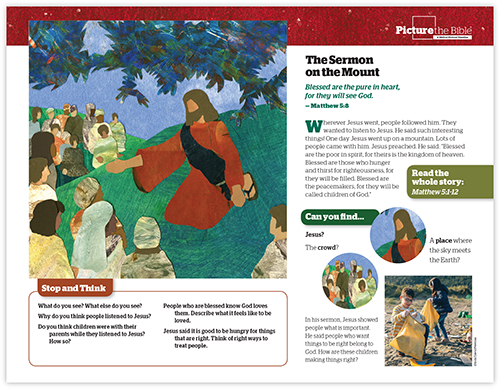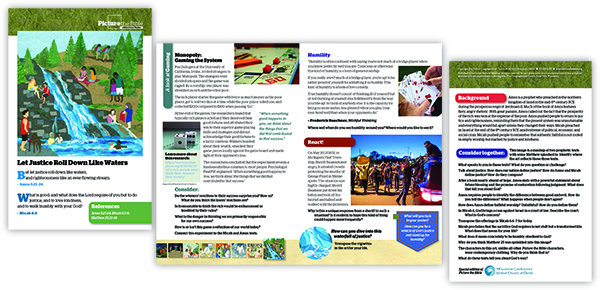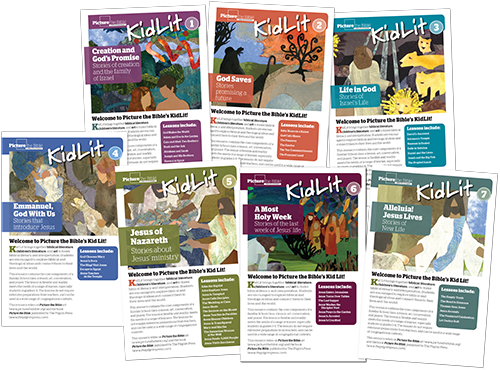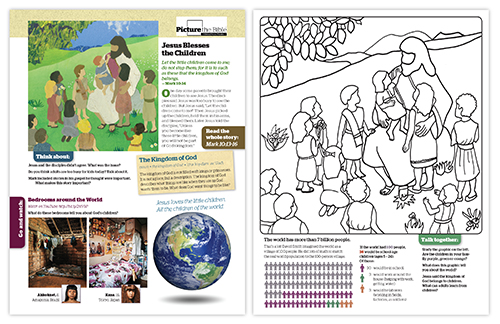4 Student Levels
Pages for different age groups have both common and unique materials. This allows for generations of people to have similar conversations in age-appropriate ways about a shared theme.
 Student Conversation Pages for grades 3-12
Student Conversation Pages for grades 3-12
- The front page features the image, memory verse, synopsis of the story matching the image, Bible reference for the whole story, and discussion questions to consider.
- The bottom of the front page relates the Bible story to the world and/or the learners’ lives.
- The bottom banner on the front features the Picture the Bible images, in order, with the focus image larger and in the middle. This feature reminds learners of the context of individual Bible stories.
- The back page provides an opportunity explore the Bible story and its related themes through science, art, history, music and so on.
- Dictionary definitions: Some concepts are specifically defined in a box.
KidLit for grades 3–12, a NEW curriculum series
 KidLit invites learners to explore God’s way and imagine participating in that hope and vision for the world. Each KidLit lesson weaves together a Bible story, timeless children’s literature, and a creative art project to foster meaningful conversations at the intersection of faith and life.
KidLit invites learners to explore God’s way and imagine participating in that hope and vision for the world. Each KidLit lesson weaves together a Bible story, timeless children’s literature, and a creative art project to foster meaningful conversations at the intersection of faith and life.
The lessons are:
- flexible to meet the interests and needs of learners in kindergarten through Grade 6.
- readily implemented and require little preparation.
- effective for a wide range of contexts.
All seven KidLit resources together will bring you 52 stories from Picture the Bible in this easy-to-use new resource. The resources can be used in any order.
Family Pages for families, young readers, and multi-age groups
Family pages were developed for in-home use. They are also an excellent resource for young readers (grades 1-3), intergenerational settings, retreats, and groups with a wide age range.
- The front page features ideas to talk about appropriate for a wide range of ages.
- The back page includes a picture to color as well as conversation starters that connect the Bible text and contemporary life.
 PreSchool Pages for prereaders
PreSchool Pages for prereaders
- The front page focuses on questions and ideas specifically geared to helping young children experience the art and explore the story.
- The back page is a coloring page matching the art.
 Adult Pages for grades 9—adults
Adult Pages for grades 9—adults
Slightly different format enables adults to follow the discussion with the text in a Bible. NOTE: Not all Adult pages are completed.
- The front page features the image, memory verse, synopsis of the story matching the image, Bible reference for the whole story, and discussion questions to consider.
- The inside pages include a variety of ideas to discuss and information to explore.
- The inside bottom pocket graphic poses two summary questions about the story. What will you take with you?
- The back page offers background about the text and a list of questions to consider.
Using the Resource Pages
Embedded in the resources pages are ideas and images to engage people in the conversation. Leaders and learners move through the pages together, learning from each other. A few suggestions:
- Use the resources pages to help learners explore the Bible text and relate it to their own lives. With few exceptions there are no “right” or “wrong” answers to the discussion questions.
- Move through the page in a way that works for your group. There is no prescribed path through the page, although it makes good sense to start with the top front as it introduces the Bible text, art, and identifies the theme.
- Ask questions that encourage learners to explore the text and ideas deeply and reflectively.
Asking Questions
The questions you ask have a lot to say about the character of your conversation. In general ask fewer questions to test learners’ memories (How many disciples are there?) and more questions designed to explore ideas. Some suggestions:
- How do you think about…? How else could you describe…?
- If you were the character, what would you do?
- What’s the most important idea in this story?
- How would you feel if…?
- Why do you think Jesus said…?
- Find evidence to show that God acts in surprising ways?
- How do these stories fit together? What does this story tell you about God’s way?
When could I use these resources?
The short answer is use them when it is right for you and your congregation. The longer answer is these resources could:
- become the focus of Sundays (worship and education);
- provide the basis for multi-generational in-person gatherings on your church lawn;
- be the center of Sunday School or faith formation events;
- provide curriculum for a series of Zoom adult Bible studies;
- be woven into your confirmation program;
- support at-home education for your families;
- inspire you to be creative and find a time and opportunity that fits your ministry needs and goals.
How do I use these resources?
Picture the Bible resources support biblical literacy and interpretation through conversation. “Conversation” is key. The resources are designed to get people of all ages talking about Bible texts, wondering what they meant to their first listeners, and asking what these ancient, yet always new texts say to us in our world today. The pages intentionally blur the line between leader and learner so all participants have the opportunity to contribute ideas.
Leaders do not need to take much time for preparation and do not necessarily need theological training.


